Life Processes | Olympiad Preparation for Class 10 PDF Download
The basic functions performed by organisms to maintain their life on Earth are called life processes.
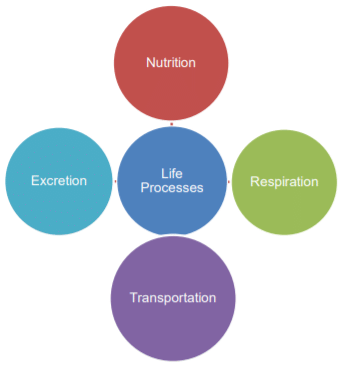
Nutrition
Autotrophic Nutrition
- It is the mode of nutrition in which organisms synthesise their own food from simple inorganic
- substances such as water and carbon dioxide.
- Green plants are autotrophs. They synthesise food by the process of photosynthesis.
- Photosynthesis is a physiological process by which plant cells containing chlorophyll produce food in the form of carbohydrates using carbon dioxide, water and light energy. Oxygen is released as a byproduct of this process.
- Chlorophyll is the green pigment found in green plants.
- Chlorophyll is present in chloroplasts.
- Chloroplast is a membrane-bound oval cell organelle.

- It is enclosed by a double membrane. Its interior contains closely packed flattened sacs called
- thylakoids. Chlorophyll is present in the thylakoids.
- Thylakoids are arranged in piles called grana lying in a colourless ground substance called stroma.
- Cells present in the spongy mesophyll layer and the palisade layer contain chloroplasts; therefore, they are the site of photosynthesis.
Stomata
- Stomata are minute openings present in the epidermal layers of leaves.
- They are responsible for gas exchange during photosynthesis.
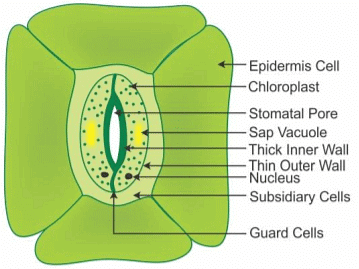
Process of Photosynthesis
- The palisade layer is the centre for photosynthesis. Light energy is trapped in the chlorophyll of the mesophyll cells in the palisade layer of leaves.
- The chemical equation for photosynthesis is

- Light is absorbed by chlorophyll.
- Light energy absorbed is converted into chemical energy.
- At the same time photolysis of water takes place i.e. a water molecule is split into
- hydrogen and oxygen.
- Carbon dioxide is converted into glucose by using ATP and NADPH produced during the light reaction.
- Chlorophyll, light, carbon dioxide and water are necessary for photosynthesis.
Heterotrophic Nutrition
- It is the mode of nutrition of organisms which cannot synthesise their own food, but they are dependent on other organisms for food.
- Organisms exhibiting heterotrophic nutrition are called heterotrophs. Examples: yeasts, fungi, bacteria, human beings, tiger, monkey, birds, lion, cow etc.
Types of Heterotrophic Nutrition
- Saprotrophic Nutrition: Organisms obtain their food from dead, decaying plants and animals. Example: Mushrooms
- Parasitic Nutrition: Organisms obtain their food from the bodies of other living organisms. Parasites usually harm the host while obtaining their food. Example: Leech
- Holozoic Nutrition: It is a mode of nutrition in which organisms feed on solid food. The food is complex organic material which when ingested is broken down into simple inorganic substances by the process of digestion. Example: Humans

Nutrition in Amoeba
- Amoeba engulfs its food by temporary finger-like projections of its body surface called pseudopodia.
- When a pseudopodium fuses with the food particle, it forms a food vacuole.
- Complex substances are broken down into simple substances inside the food vacuole. These simple substances are then diffused into the cytoplasm.
- The remaining unwanted material is transported to the cell surface and is thrown out.
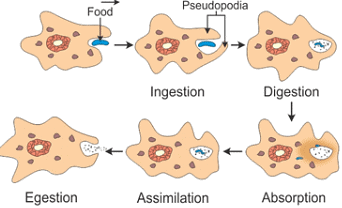
Nutrition in Paramecium
- The food is taken in at a specific spot, i.e. the oral groove.
- The food is brought close to the oral groove by the cilia present on the body surface of paramecium.
Nutrition in Human Beings
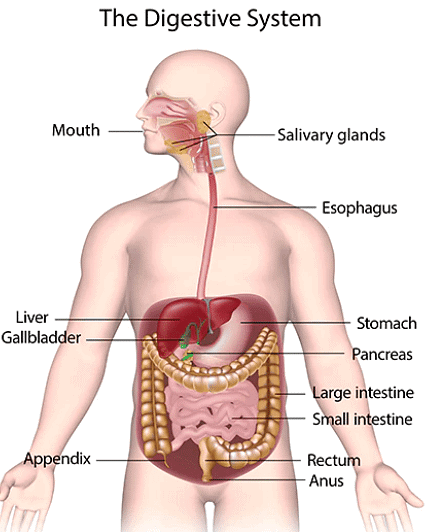 The alimentary canal is the long tube extending from the mouth to the anus.
The alimentary canal is the long tube extending from the mouth to the anus.
- Food is chewed and mixed with saliva in the mouth with the help of tongue and teeth.
- Saliva which contains salivary amylase acts on the starch present in food.
- Saliva is secreted by 3 pairs of salivary glands.
- The food is converted into smaller particles and made smooth by mixing it with mucus and saliva. It is now called bolus.
- The bolus moves down through the oesophagus by peristaltic movements of the oesophageal wall.
- Once the bolus reaches the stomach, it is acted upon by HCl, gastric juices and pepsin.
- HCl creates an acidic medium for the action of pepsin.
- Mucus prevents the lining of the stomach wall from the acidic environment.
- Pepsin converts proteins into peptides.
- The exit of food from the stomach is regulated by a sphincter muscle called the pyloric sphincter or pylorus which releases small amounts of partially digested food into the small intestine.
- The small intestine is a very long tube found in the abdomen. It is about 6–7 metre in length and about 2.5–3 cm wide.
- Bile and pancreatic juices are secreted into the small intestine.
- Bile acts on the fat molecules and breaks them into small flat droplets. This eases the action of lipase on the fats. This process is called emulsification.
- Pancreatic juices contain different enzymes such as trypsin, lipase, maltase, peptidases, sucrose, which act on the food to convert it into simpler units of carbohydrates, proteins and fats.
- Intestinal glands also secrete intestinal juices which also contain enzymes, which act on the carbohydrates, proteins and fats.
- The digested food is then absorbed by the walls of the small intestine.
- Presence of brush-like borders called microvilli increase the surface area for absorption.
- The unabsorbed food is sent to the large intestine where water is absorbed into the blood stream.
- The left over material in the large intestine is sent to the rectum.
- It is excreted out through the anus.
- The opening of the anus is controlled by the anal sphincters.
Respiration
- Respiration is a catabolic process of releasing energy from the simple sugar glucose for carrying out various life processes.

- The energy required for all cellular activities is obtained by the oxidation of glucose.
- If glucose is not available, then the cells may break down proteins and fats to produce glucose. This glucose is then oxidised further to fulfil the respiratory needs of the cell.
- The first step towards obtaining energy is that the six-carbon glucose is broken down into two molecules of three-carbon pyruvate. This process takes place in the cytoplasm.
Aerobic Respiration
- The breakdown of glucose in the presence of oxygen is called aerobic respiration.
- The process of aerobic respiration releases carbon dioxide, water and energy.
- The energy released in aerobic respiration is 686 kcal or 38 ATP of chemical energy and 420 kcal of heat energy.
- Most of the animals, plants, human beings, several bacteria and fungi are aerobic.
Anaerobic Respiration
- The breakdown of glucose in the absence of oxygen is called anaerobic respiration.
- The process of anaerobic respiration results in the formation of ethanol (in plants) or lactic acid (in animals), along with the release of carbon dioxide and energy.
- Water is not released in this process.
- 2 ATPs are released during anaerobic respiration.
- During heavy physical exercise such as cycling, running or lifting heavy weights, the body is often
- deprived of oxygen. The demand for energy is high, while the supply of oxygen to the body is limited. Therefore, muscle cells perform anaerobic respiration to fulfil the increasing energy demands of the body. In this case, glucose gets converted to lactic acid.

- Sometimes, lactic acid formed during anaerobic respiration in muscle cells gets accumulated, causing muscular cramps. This condition is called oxygen debt. In the presence of sufficient oxygen, lactic acid gets oxidised to carbon dioxide and water.
Respiration in Plants
- All parts of a plant perform respiration.
- Plants exchange gases by diffusion through the stomata.
- Oxygen from the air diffuses into a leaf and reaches all the cells for respiration.
- Carbon dioxide produced during respiration is released into the air through the stomata.
- In plants, respiration occurs during the day as well as during the night.
- During the day, oxygen produced during photosynthesis is used for respiration and the extra amount of oxygen is given out through the stomata.
- The roots of plants take up oxygen from the air present between the roots and soil particles.
- In stems, the exchange of gases occurs through either the stomata or lenticels.
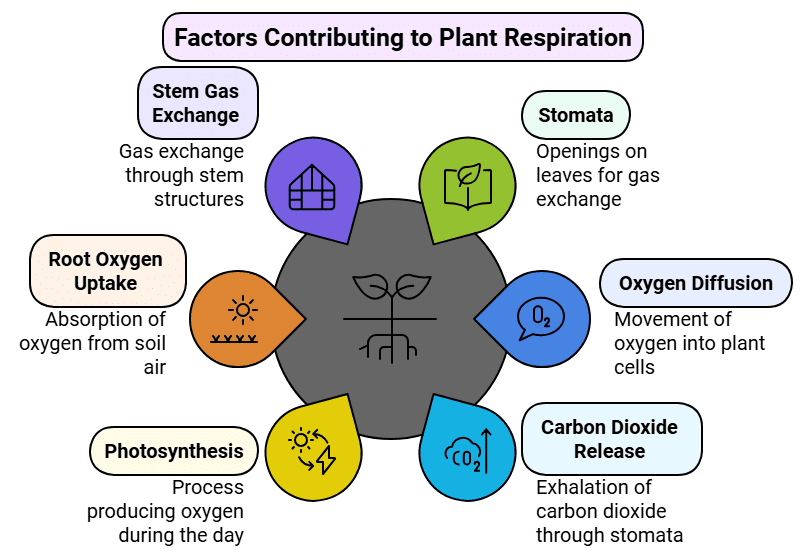
Respiration in Animals
Different animals have evolved different respiratory organs:
- Amoeba: Simple diffusion through the cell membrane
- Earthworm: Skin
- Fish: Gills
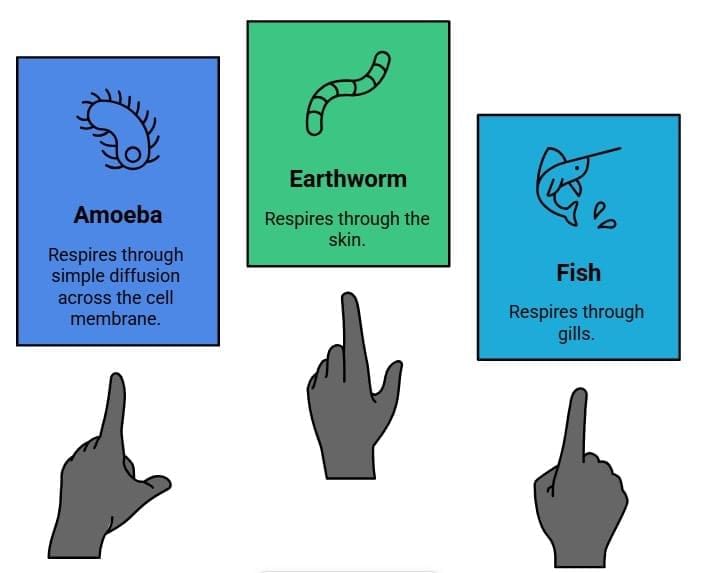
Human Respiratory System
The respiratory system in human beings consists of the nose, pharynx, larynx, trachea, bronchi and lungs.
- Air is taken in through the nostrils.
- Hairs present in the nostrils prevent the entry of dust particles inside the nose.
- Nostrils further continue into the nasal cavity.
- Nostrils humidify the air passing through it.
- There is a bony plate called the palate, which separates the oral cavity from the nasal cavity.
- Nasal cavity opens into the pharynx.
- The pharynx is a muscular chamber acting as a common passage for the windpipe or trachea and the food pipe or oesophagus.
- It is connected to the larynx through a slit-like opening called the glottis.
- The larynx is also called the voice-box or Adam's apple.
- The larynx connects the pharynx to the trachea.
- The trachea shows the presence of cartilaginous rings.
- The cartilaginous rings provide flexibility thus, facilitating continuous air flow.
- The inner wall of the trachea is lined by a mucous membrane consisting of ciliated columnar epithelium.
- The trachea divides into two branches or tubes called bronchi, one of which enters the right lung and the other enters the left lung.
- The bronchi have cartilaginous rings for distention.
- Each bronchus divides into fine secondary bronchi. These bronchi further divide into finer tertiary bronchi. In the lungs, each bronchus finally divides into finer and smaller branches called bronchioles.
- The bronchioles further divide to form smaller terminal bronchioles.
- The bronchioles divide repeatedly to form a cluster of tiny air chambers called air sacs or alveoli.
- Alveoli have thin and moist walls which enable gaseous diffusion with blood capillaries.
- The lungs are a pair of spongy and elastic respiratory organs protected by a bony rib cage.
- The base of the lungs rests on the diaphragm.
- Each lung is covered by two membranes. The inner membrane is called the inner or visceral pleura and the outer membrane is called the outer or parietal pleura.
- The diaphragm is a curved, musculo-fibrous sheath which separates the thoracic cavity from the abdominal cavity.
- The diaphragm plays a major role during respiration.
- The intercostal muscles found between the ribs and the radial muscles of the diaphragm bring about the breathing movements.
- When we breathe in, the ribs are pulled upwards and the diaphragm becomes flat which results in an increase in the volume of lungs.
- When we breathe out, the ribs come back to their normal position, the diaphragm is relaxed, lungs attain their normal size and air is expelled out of the body through the nostrils.
Transportation
Transportation in Human Beings
Blood
- Blood is a liquid connective tissue.
Functions of Blood
1. Transportation
- Transports oxygen from the lungs to the tissues and carbon dioxide from the tissues to
- the lungs.
- Transports cellular waste products from the tissues to the kidneys.
- Transports nutrients from the intestine to the tissues.
- Carries hormones from the place where they are produced to the target organ.
2. Defense Mechanism
- White blood cells destroy disease-causing microorganisms and thus help in preventing infections.
- Blood platelets prevent excessive blood loss by blood clotting.
3. Regulatory Functions
- Blood maintains the water balance in the tissues and organs of the body.
- It also regulates the body temperature by distributing the heat in different parts of the body.
Composition of Blood
1. Plasma
- It is a light yellow-coloured or straw-coloured liquid.
- It constitutes 55% of the total blood volume.
2. Blood Cells
- Blood cells constitute 45% of the total blood volume.
- Three kinds of cells are found in the blood.
Red Blood Cells (RBCs/erythrocytes)
- RBCs are circular, disc-shaped and biconcave.
- They are produced in the bone marrow of long bones.
- Mature RBCs do not have nuclei.
- The lifespan of RBCs is 120 days.
- RBCs are made up of a ironcontaining respiratory pigment called haemoglobin.
- Haemoglobin transports oxygen from the lungs to tissues.
White Blood Cells (WBCs/leucocytes)
- Irregular, colourless, larger than RBCs. They have a large and lobed nucleus.
- WBCs are produced in the bone marrow, lymph glands and spleen.
- WBCs provide immunity.
Blood Platelets (Thrombocytes)
- Blood platelets are minute, oval or round, nonnucleated cells.
- Platelets are formed in the bone marrow.
- Blood platelets play an important role in blood clotting.
Heart – The Pumping Organ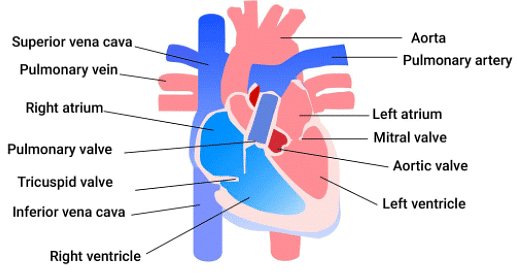
- Heart is the muscular pumping organ which pushes the blood around the body.
- Blood transports carbon dioxide to the lungs for oxygen from the cells for removal and carries oxygen from the lungs to the heart and heart pump the blood to all the cells of the body.
- Heart has different chambers such as right atrium, left atrium, right ventricle, left ventricle to prevent the mixing of oxygenated blood and carbon dioxide rich blood.
- The thin walled upper chamber, left atrium, relaxes and oxygenated blood enters it.
- Left atrium then contracts and the next chamber left ventricle, expands and thus blood enters it.
- When the left ventricle contracts the blood is pumped out to all the cells of the body.
- Deoxygenated blood from the body reaches the right upper chamber, right atrium when it expands.
- As the right atrium contacts, the lower chamber, right ventricle, dilates.
- Separation of right and left side of heart allows efficient supply of oxygen to the body and useful for animals that have high energy needs to maintain their body temperature.
- In some animals, body temperature depends on the temperature in the environment and thus they do not use energy to maintain body temperature.
- Amphibians and reptiles have three chambered heart and allows some mixing of oxygen and deoxygenated blood.
- Fishes have two chambered heart and the blood is pumped to the gills for oxygenation and transported directly to all the cells of the body.
- When blood goes through the heart twice during each cycle, the process is called as double circulation.
- In fish, blood goes only once through the heart and thus fish shows single circulation.
Double Circulation
The heart receives deoxygenated blood from different parts of the body, and it pumps this blood to the lungs. The oxygenated blood from the lungs returns to the heart, which is pumped again into different parts of the body by the heart. Thus, the blood passes twice through the heart making one complete round through the body. This is called double circulation.
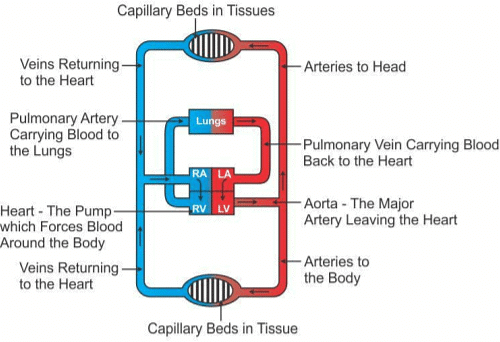
The pulmonary circulation pertains to lungs. The blood flows from the right ventricle to the lungs. Pulmonary veins collect oxygenated blood from the lungs and carry it back to the heart (left auricle). The systemic circulation pertains to the major circulation of the body. The aorta receives the blood from the left ventricle and sends it to the various parts of the body. Veins collect the deoxygenated blood from the body parts and pour it back into the right auricle.
Blood Pressure
- Blood pressure is the pressure which the blood exerts on the walls of the blood vessels.
- The blood pressure in the arteries during ventricular systole is called systolic pressure, and the blood pressure in the arteries during the ventricular diastole is called diastolic pressure.
- A person’s blood pressure is usually expressed in systolic pressure over diastolic pressure.
- The normal blood pressure for an adult human is 120/80 mm Hg.
- Blood pressure varies according to the age and health of a person.
- A sphygmomanometer is an instrument used to measure blood pressure.
- High blood pressure is also called hypertension, while low blood pressure is called hypotension.
Blood Vessels
- The blood vessels are tubes from which blood from the heart is carried to all parts of the body and again brought back to the heart.
There are three types of blood vessels.
- Arteries carry blood away from your heart.
- Veins carry blood back toward your heart.
- Capillaries, the smallest blood vessels, connect arteries and veins.
Lymph and Lymphatic System
- As the blood flows through capillaries, the water, dissolved substances and a few white blood cells pass through the capillary walls into the spaces between the cells, i.e. intercellular spaces. This fluid is called tissue fluid.
- White blood cells in the lymph protect the body against diseases.
- The lymphatic system carries excessive tissue fluid back to the blood.
- Some tissue fluid enters tiny vessels called lymph capillaries. Lymph capillaries further join to form lymph vessels.
- Lymph vessels together with small sac-like structures called lymph nodes form the lymphatic system.
- Lymph vessels from different parts of the body join to form ducts or tubes.
- The colourless fluid which flows within the lymphatic system is called lymph.
Clotting of Blood (Coagulation)
- When a blood vessel is cut, blood escapes from it. Soon a clot is formed on the wound, and the flow is stopped.
- Blood clotting is a complex process:
- The platelets release an enzyme at the site of injury.
- This enzyme converts fibrinogen present in the blood plasma into fibrin.
- Fibrin forms a fine mesh into which RBCs get trapped.
- Fibrin along with the trapped RBCs contracts and forms a clot, thus stopping the
- bleeding.
Transportation in Plants
- Transportation in plants is the process by which a substance, absorbed or synthesised in one part of the plant, is transported to the other parts of the plant.
- Substances transported by the transport system are water, mineral and food prepared by plants.
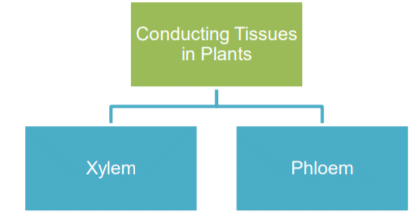
1. Xylem
- It conducts water upwards in a plant.
- Xylem also provides strength to the stem and helps the plant to stand upright.
- It is located in the centre of the plant body.
- Xylem mainly consists of tracheids and vessels.
Mechanism of Transport of Water and Minerals
- Water enters the root hair through osmosis, and mineral ions enter the root cells by active
- transport.
- Both water and minerals move upward from cell to cell through the cortex of the root by osmosis.
- From the cortex, water and minerals are brought to the xylem.
- The sap which contains water and dissolved minerals move upwards from the root cells to xylem.
- The upward movement of sap is called the ascent of sap.
- The xylem vessels of the roots are in continuation with the xylem vessels of the stem.
- Transpiration is the loss of water in the form of water vapour from the aerial parts of a plant.
- It occurs through openings called stomata.
- Water loss through evaporation lowers the concentration of water inside the mesophyll cells.
- Due to this, water enters mesophyll cells from neighbouring xylem vessels through osmosis.
- As water evaporates from the leaves, a suction force is created. This force helps to draw more
- water up through the stem which causes the roots to absorb more water from the soil.
- Higher the rate of transpiration, greater the rate of absorption of water and solutes from the soil.
- Transpiration also helps in maintaining the temperature of the plant body.
2. Phloem
- It conducts manufactured food from the leaves to different parts of the plant.
- The food in the phloem can move in the upward and downward directions.
- Phloem mainly consists of sieve tube cells and companion cells.
- Sieve tubes are living cells of the phloem. They contain cytoplasm but no nucleus.
- The end walls of the cells form sieve plates.
- Sieve plates have small pores in them which allow food to pass through the phloem.
- Each sieve tube cell has a companion cell next to it.
Mechanism of Transport of Water and Minerals
- Food synthesised during photosynthesis is loaded into sieve tubes by utilising ATP.
- The presence of food inside the phloem develops the concentration gradient for water. Thus, water enters the phloem by osmosis.
- Osmosis develops high pressure inside the phloem which transports the food from the phloem to
- plant parts where the concentration of food is less.
- This process is called translocation.
- In spring, the sugar stored in the root or stem tissues is transported to the buds.
Xylem and phloem constitute the conducting tissues and are known as vascular tissues.
Excretion
Excretion is the removal of harmful and unwanted substances, especially nitrogenous wastes, from the body.
The human urinary system consists of
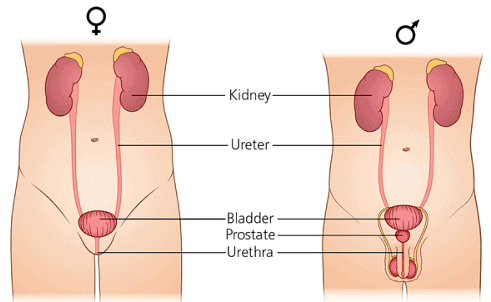
- Pair of kidneys:
- Dark red, bean-shaped, 10 cm long, 6 cm wide. The right side of the kidney is slightly lower in position due to the presence of the liver.
- Pair of ureters:
- Ureters are tube-like structures which arise from the notch, i.e. the hilum of each kidney.
The ureters connect behind with the urinary bladder.
The ureters carry the urine produced to the urinary bladder
Urinary bladder:
Muscular sac-like structure.
It stores urine temporarily.
Its opening is guarded by muscular sphincters.
The sphincters open at the time of micturition (urination)
- Urethra:
- Short muscular tube which expels urine out of the body.
- The urethra is long in males and is very short in females.
- The opening is guarded by sphincters which open at the time of urination.
Uriniferous Tubule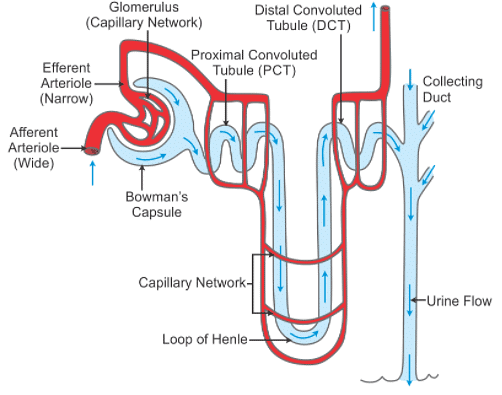
- Each kidney is composed of an enormous number of uriniferous tubules.
- They are also known as nephrons, renal tubules or kidney tubules.
- Uriniferous tubules are the structural and functional units of the kidney.
Malpighian Tubule
- Each nephron has a Malpighian body and body of tubules.
- Malpighian body is nothing but a cup-shaped Bowman’s capsule. In its cup-shaped depression, a tuft of blood capillaries called glomerulus is situated.
- The body of tubules contains proximal convoluted tubule (PCT), loop of Henle and distal convoluted tubule (DCT).
- DCT opens into the collecting duct
Formation of Urine
The process of urine formation occurs in two major steps.
1. Ultrafiltration
- The efferent arteriole is narrower than the afferent arteriole which develops a hydrostatic pressure on the blood.
- Thus, the blood flows through the glomerulus with a great pressure.
- Due to the pressure, the liquid part of the blood filters out from the glomerulus and passes into the Bowman’s capsule.
- The glomerular filtrate consists of water, urea, salts, glucose and other plasma solutes.
- Blood corpuscles, proteins and other large molecules remain behind in the glomerulus.
- Therefore, the blood carried away by the efferent arteriole is relatively thick.
2. Reabsorption
- The glomerular filtrate entering the renal tubule contains many useful substances.
- Hence, as the filtrate passes down the tubule, water and other substances required by the body are reabsorbed.
- Potassium ions and certain substances such as penicillin are passed into the forming urine through the distal convoluted tubule (DCT).
- The cells of the walls of DCT are involved in bringing potassium ions and
- other substances back into the renal tubule; hence, this process is known as tubular secretion.
Urine Excretion
- The filtrate left after reabsorption and tubular secretion is called urine.
- The urine passes from the collecting duct into the pelvis of the kidney. From there it is sent to the
- urinary bladder through the ureters.
- By relaxing the sphincters present at the opening of the urethra, the urine is expelled from the body.
- This process is known as micturition or urination.
Excretion in Plants
- Plants also produce several waste products during their life processes.
- The major waste products are water, carbon dioxide and oxygen produced during respiration and
- photosynthesis.
- These wastes are excreted through the stomata and lenticels.
- Plants store some waste products in leaves which fall off.
- Wastes such as gums and resins are stored in the old xylem.
|
70 videos|242 docs|187 tests
|
FAQs on Life Processes - Olympiad Preparation for Class 10
| 1. What are the main types of transportation in living organisms? |  |
| 2. How does transportation occur in plants? |  |
| 3. What role does the circulatory system play in transportation? |  |
| 4. What is the significance of transport processes in life processes? |  |
| 5. How do diffusion and active transport differ? |  |
















